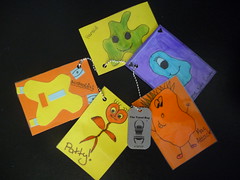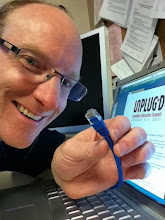Although I'd known about Geocaching for some time, it took an invitation from Jarrod Robinson for me to undertake a first hand exploration of this growing phenomenon. An overview of the Australian origins of this project is included in this brief audio podcast:
At the launch of the project, Mr. Robbo: The P.E. Geek, posted this video introduction to the monsters project:
On Saturday, we went treasure hunting!
 Step 1: The monsters arrived via air mail from Australia. We unpacked the envelope and discovered a number of hand-drawn monsters, attached to a Travel Bug.
Step 1: The monsters arrived via air mail from Australia. We unpacked the envelope and discovered a number of hand-drawn monsters, attached to a Travel Bug.Step 2: After recording the tracking number of the Travel Bug, we documented the arrival of the attached monsters at Geocaching.com.
 Step 3: We chose an existing cache at the Komoka Railway Museum, as the first hiding place for the monsters.
Step 3: We chose an existing cache at the Komoka Railway Museum, as the first hiding place for the monsters.As much as it was fun to play hide & seek via geocaching, we discovered a number of additional, unanticipated treasures:
making treasure maps;
climbing on rail cars;
hearing stock car races echo in the valley;
hiking around the Kilworth pond,
confirming that beavers live in the neighbourhood.
We had a gorgeous day to explore, but I suspect this recreational hobby can be enjoyed year-round. If you're interested to learn what may be hiding in your neighbourhood, simply input your postal/zip code at Geocaching website, then take the next step, and seek out the hidden treasure!
For more photos of our hike, visit my Geocaching photos via Flickr.



